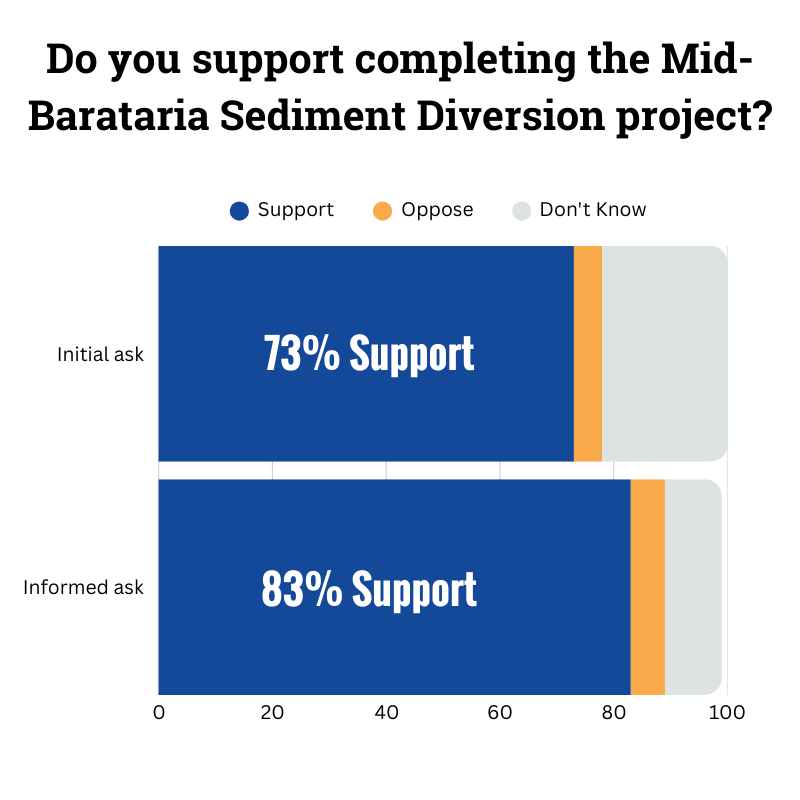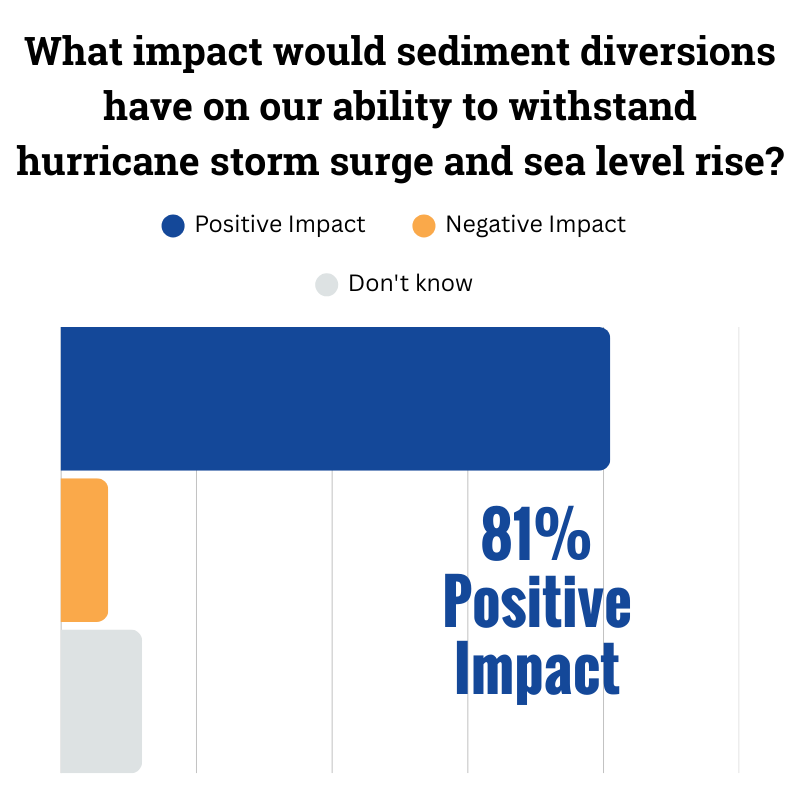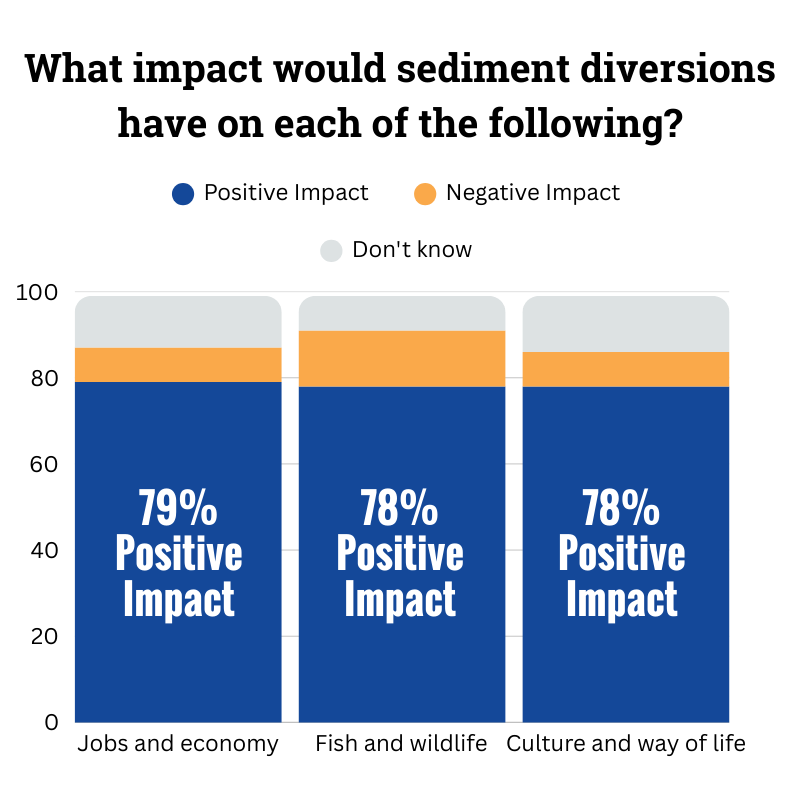MBSD is a State Priority But It Isn’t Costing Taxpayers
The state must uphold CPRA’s mandate to protect Louisiana’s coast and the state’s business climate.
1. Conserving Louisiana Working Coast is a State Priority: Following the devastating hurricanes of 2005, the Coastal Protection and Restoration Authority (CPRA) was created as Louisiana’s lead agency for coastal protection and restoration, establishing concrete action steps through the creation of the Coastal Master Plan. Independent polling conducted in 2025 found that 83% of Louisiana residents support the MBSD. In Plaquemines and St. Bernard, 85% of residents polled supported sediment diversions.
2. MBSD is Fully Funded through the Deepwater Horizon Settlement: MBSD’s funding does not come from taxpayer dollars, but through the RESTORE Act created after the BP spill. These funds follow a strict federal-state process. Abandoning or modifying MBSD would burden the state with paying back the already-spent $600 million from the state’s general fund. It would also freeze the remaining $2.4 billion until a new project could be proposed, evaluated and permitted and there is no guarantee Louisiana would hold onto these funds.
3. CPRA’s Reversal Could Risk State Authority: CPRA is the single entity responsible for coastal restoration projects like MBSD. Local parish governments cannot legally override this authority. By taking this project to court, CPRA risks setting a precedent that weakens state authority over parishes and emboldens individuals on other issues such as education or public safety.
Protecting Lives and Homes from Hurricanes and Flooding
1. Flood Protection for Greater New Orleans: MBSD will create a natural flood buffer zone to manage sea level rise and extreme storm surges, reducing flood risk for 1.2 million people in greater New Orleans, protecting lives, homes and businesses.
2. Support for Westbank Parishes: As part of MBSD, $378 million will be provided to West Bank parishes to raise homes or relocate them to safer areas, further reducing flood risk.
Statewide Support for Sediment Diversions and the MBSD
Nearly three-quarters (73%) support the MBSD project, and that jumps to 83% once they learn it’s fully funded by BP oil spill settlement dollars. MBSD comes at no cost to taxpayers, but delays make storm impacts and insurance costs rise.

MBSD is about more than land loss – it’s about safety. Voters say the number one reason to move forward with MBSD is protection from hurricanes and rising seas. With hurricanes worsening and insurance rates skyrocketing, delaying action puts homes, businesses and lives at risk.

Voters believe sediment diversions will have positive impacts on important metrics in coastal Louisiana such as jobs and the economy, fish and wildlife, and our culture and way of life. Louisianians overwhelmingly support sediment diversions because it means safer communities, a stronger economy, and a better future. We can’t afford to wait.

Nature, Science and Process Prove MBSD Works
Decades of world-class, best-available science and 50,000+ public comments back MBSD. Substitutions or alternative proposals lack evidence of success.
1. Louisiana’s Best Land-Building Tool: The Mississippi River built up coastal Louisiana by depositing sediment and fresh water over thousands of years. Mimicking that process is the only way to rebuild coastal wetlands durably at scale. A critical proof point—the only areas gaining land in Louisiana today are places that receive river inputs, such as the Atchafalaya Bay.
2. Wetlands Protect Against Hurricanes, Storms and Everyday Flooding: Wetlands, such as MBSD will build, act as a sponge to trap and slowly release water, reducing flooding in communities.
3. Land Loss will Continue without MBSD: Without intervention, Plaquemines Parish could lose as much as 55% of its land area over the next 50 years, bringing sea level rise closer to New Orleans. Only MBSD addresses this problem at its root.
4. More Durable than Dredging: Dredging, an alternative suggested, is a short-term solution (20 years), that would start eroding again as soon as the pumps turn off. MBSD reintroduces sediment and freshwater naturally and continuously for at least 50 years.
More Cost-effective and Longer Lasting than Dredging
Dredging projects are short term solutions that do not address the root cause of the problem—sediment starvation, subsidence, lack of freshwater, and sea level rise. Dredging projects begin to sink as soon as the pumps turn off and are only expected to have a 20-year lifespan. The diversion reintroduces sediment and freshwater in a way that can combat sea level rise and subsidence nourishing both naturally built and dredged wetlands as long as it continues to run—at least fifty years.
CPRA estimates it would cost ~$5 billion to create as much land as MBSD through dredging and the process would need to be done again after 20 years, doubling the overall cost.
| Project | Construction Cost | Acres Produced | Cost/Acre | Lifespan |
| Mid-Barataria Sediment Diversion Lower SLR | $2.541 Billion | 24,700 | $102,800 | 50 Years |
| Grand Bayou Ridge and Marsh Creation | $62.4 Million | 422 | $147,900 | 20 Years |
| Large Scale Barataria Marsh Creation | $181.4 Million | 1,163 | $155,900 | 20 Years |
| Grand Cheniere Ridge and Marsh Creation | $65 Million | 342 | $190,000 | 20 Years |
Economic Benefits to Louisianians
1. Jobs and Revenue: MBSD will generate $1.9 billion in Plaquemines Parish business sales, $308.2 million in household income and support 540 jobs annually over the construction period. Regionally (Plaquemines, St. Bernard, Orleans, Jefferson, St. Tammany), it will generate $2.8 billion in sales and 3,095 jobs.
2. Reduced Insurance Costs: Increased coastal buffer zones will reduce flood insurance costs for residents in the greater New Orleans area.
3. Improved Commercial and Recreational Fisheries: MBSD will improve the productivity of the higher value white shrimp as well as crawfish, key commercial fisheries in the state. It will also improve habitat and increase population sizes for largemouth bass, red drum and other fish species, bolstering the outdoor recreation industry in the state.
Robust Mitigation Measures to Reduce Impacts to Fisheries
1. Short-term Impacts: MBSD is expected to alter the salinity of the Barataria Basin. This will impact a portion, just over one-third, of Louisiana’s oyster fishery in the near-term. The fishery is not expected to experience serious losses over the lifetime of the project.
2. Significant Mitigation Funds: MBSD is providing $53 million to support oyster fishers affected by the project to shift oyster grounds, not halt them. Fishers will help control how funds are spent, whether that is building new or enhancing depleted oyster reefs, or evolving the aging workforce or improving gear.
3. Oyster Farming Already in Decline: Oysters are already under threat from environmental changes. Without MBSD, the oyster fishery will continue its decline as more marsh converts to open water, the basin’s water grows saltier, and temperatures change. MBSD’s mitigation funds will help the industry adapt to these changes long-term.
What’s the Latest on the Project and What Can You Do?
1. The Governor’s Office Has Prioritized Politics over People:
Governor Landry has sided against the majority of Louisianians and made closed door deals to stop the project with a small group of individuals who oppose it.
2. Restart the Permit and Resume Construction:
The U.S. Army Core of Engineers should work with the state to restart the permit and CPRA should defend its own legal authority, resume its work, and stop paying project penalties.
3. Collaboration on Operations Plan with Stakeholders Can Meet Concerns without Halting the Project:
MBSD is designed and permitted as a 75,000 cfs structure but it does not have to operate at that maximum flow. Adaptive management can balance land-building goals and economic impacts. Negotiation on operations should include local industry stakeholders to find a pathway to success in lieu of canceling or modifying the project.
